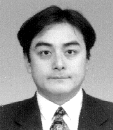

|
Yutaka AkiyamaChief, TRC Massively Parallel
Application
Laboratory |
Profile
| Affiliation:
| Massively Parallel Application Laboratory, Massively Parallel Systems
Department, Tsukuba Research Center, RWCP |
| Date of birth:
| May 30, 1961 |
| Birthplace:
| Tokyo |
| Background:
| |
| 1984
| Graduated from the Electric Engineering Department, Faculty of
Engineering, Keio University |
| 1990
| Completed the Doctorate Course of Electric Engineering, Postgraduate
School of Engineering, Keio University; Ph. D. |
| 1990
| Joined the Electrotechnical Laboratory, Agency of Industrial Science
and Technology, Ministry of International Trade and Industry, and assigned
to the Computation Models Section |
| 1992
| Appointed to associate professor of Institute for Chemical Research,
Kyoto University |
| 1996
| Joined the Real World Computing
Partnership |
I joined RWCP's Tsukuba Research Center last April. In the Massively Parallel
Application Laboratory, we are developing large-scale application programs to
demonstrate parallel computing technology. Since I have been involved in
information analysis of genes and proteins in my career, I have chosen many
biology-related subjects in this laboratory. In addition, we plan to work on
other themes including large-scale problems in electro-magnetic field
simulations and combinational optimization problems in industrial applications.
Our overall goal is to implement practical programs running on parallel
computers to be used by experts in specific areas. To achieve this goal, we are
gathering skilled members with various backgrounds. In particular, we need
participants from private companies for the development of industrial
application programs.
Until last March, I was engaged in the Human Genome Project of the Ministry
of Education as a member from Kyoto university. A tremendous amount of
calculation and data processing power and resources are required to combine,
parse, compare with past examples and interpret data on genetic information (DNA
sequence) which increases exponentially. State-of-the-art information technology
and power of parallel computers are indispensable for the purpose.
The desperate need of researchers in biology for more computer power made me
believe that the current computer engineering was far from mature. On the other
hand, I found that researchers in some application areas were often
short-sighted and their approach was a roundabout way towards solving problems.
I learned both the joys and difficulties of interdisciplinary effort through
this project. Though I belonged to the biology-related institute at that time, I
never touched a test tube but was working among supercomputers and parallel
computers.
Upon completion of the project, I decided to return from the application side
to the computer side as a researcher of computer science. It was a drastic
decision for me and my family to resign as associate professor of the university
and obtain a position in the RWCP. It was not an impulsive decision because I
had been very much interested in joining the RWC project long before. The
interest was probably instilled in me because I have seen that many researchers
around me actively engaged in the national projects.
My first encounter with computers took place when I was a junior high school
student. A UNIVAC 1106 and TOSBAC 3400 of the university's computer center
became my closest partners, perhaps this was even first love. Although their
memory capacities were very limited, they seemed almighty to me at that time.
However, they were suddenly turned out to be useless when given problems where
the number of possible combinations explosively increased. My small allowance
was used up in computer fees.
When I entered Keio University, I started to research on parallel algorithm
for VLSI such as systolic array under the guidance of Professor Aiso, and was
optimistically attracted by fine-grain parallelism. During the doctorate course,
I finally started studying neural networks - the subject I had been interested
in for years. Under the guidance of Professor Aiso and Professor Anzai, I
proposed a computation model named a "Gaussian machine" which combined a
Boltzmann machine and Hopfield network, and I applied the theory on approximate
solutions of the optimization problem. My approach was to minimize the objective
function of the optimization problem, which was essentially the matter of "0 or
1," by replacing it with continuous functions of which the extremes were almost
the same as those of the objective function. Smoother functions should be used
during the initial stages of calculation and then functions less smooth but
closer to the original objective function should be gradually used in later
stages. This gives the optimum and/or quasi-optimum solutions with surprisingly
high probabilities.
As for the simple N-queen problem, for example, the
solution can easily be obtained even when N is in the order of thousands. This
approach is effective for problems that contain a large number of hypotheses in
both a competitive and cooperative manner. With its parallel nature of various
levels, it is especially suitable for parallel computers.
I started applying this approach to genetic information analyses when I was
working for the Electrotechnical Laboratory because I thought the nature of the
problem space was straightforward and a deep basin existed around its optimum
solution.
In an effort to get slightly closer to the prediction of the
three-dimensional structure of proteins, which is one of the hardest problems
supposedly worthy of the Nobel Prize, I shall try to combine the parallelization
of biophysical calculations with such powerful approximation approaches in the
RWC project.

